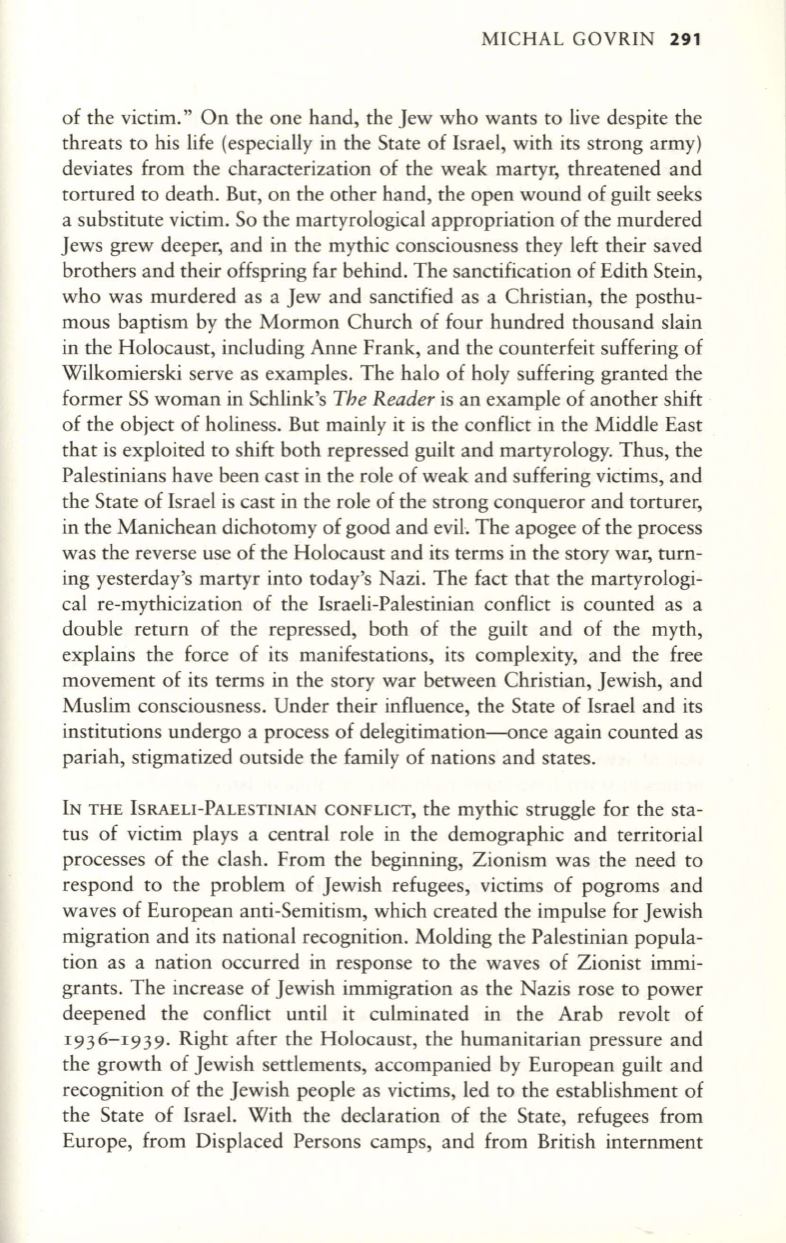
MICHAL GOVRIN
291
of the victim." On the one hand, the Jew who wants to live despite the
threats to his life (especially in the State of Israel, with its strong army)
deviates from the characterization of the weak martyr, threatened and
tortured to death. But, on the other hand, the open wound of guilt seeks
a substitute victim. So the martyrological appropriation of the murdered
Jews grew deeper, and in the mythic consciousness they left their saved
brothers and their offspring far behind. The sanctification of Edith Stein,
who was murdered as a Jew and sanctified as a Christian, the posthu–
mous baptism by the Mormon Church of four hundred thousand slain
in the Holocaust, including Anne Frank, and the counterfeit suffering of
Wilkomierski serve as examples. The halo of holy suffering granted the
former SS woman in Schlink's
The Reader
is an example of another shift
of the object of holiness. But mainly it is the conflict in the Middle East
that is exploited to shift both repressed guilt and martyrology. Thus, the
Palestinians have been cast in the role of weak and suffering victims, and
the State of Israel is cast in the role of the strong conqueror and torturer,
in the Manichean dichotomy of good and eviL The apogee of the process
was the reverse use of the Holocaust and its terms in the story war, turn–
ing yesterday's martyr into today's Nazi. The fact that the martyrologi–
cal re-mythiciza tion of the Israeli-Palestinian conflict is counted as a
double return of the repressed, both of the guilt and of the myth,
explains the force of its manifestations, its complexity, and the free
movement of its terms in the story war between Christian, Jewish, and
Muslim consciousness. Under their influence, the State of Israel and its
institutions undergo a process of delegitimation-once again counted as
pariah, stigmatized outside the family of nations and states.
IN THE ISRAELI-PALESTINIAN CONFLICT, the mythic struggle for the sta–
tus of victim plays a central role in the demographic and territorial
processes of the clash. From the beginning, Zionism was the need to
respond to the problem of Jewish refugees, victims of pogroms and
waves of European anti-Semitism, which created the impulse for Jewish
migration and its national recognition. Molding the Palestinian popula–
tion as a nation occurred in response to the waves of Zionist immi–
grants. The increase of Jewish immigration as the Nazis rose to power
deepened the conflict until it culminated in the Arab revolt of
I936-I939.
Right after the Holocaust, the humanitarian pressure and
the growth of Jewish settlements, accompanied by European guilt and
recognition of the Jewish people as victims, led to the establishment of
the State of Israel. With the declaration of the State, refugees from
Europe, from Displaced Persons camps, and from British internment


